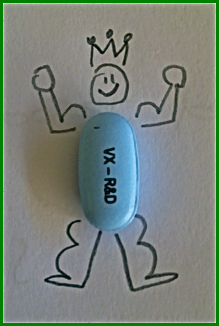Tuesday, November 26, 2013
In setting prices for medicines more important than his usefulness and value
In setting the price of the drug is important its utility and value In January 2012, the Office of the United States by the Food and Drug Administration approved the drug Kalydeco, who became the first drug to treat the underlying cause of cystic fibrosis. It made it just three months after his examination. It was one of the fastest new drug approvals in the history of the agency. Designed and developed by the drug company Vertex Pharmaceuticals has appointed him the price at 294,000 dollars a year, and Kalydeco has become one of the most expensive drugs in the world.
In January 2012, the Office of the United States by the Food and Drug Administration approved the drug Kalydeco, who became the first drug to treat the underlying cause of cystic fibrosis. It made it just three months after his examination. It was one of the fastest new drug approvals in the history of the agency. Designed and developed by the drug company Vertex Pharmaceuticals has appointed him the price at 294,000 dollars a year, and Kalydeco has become one of the most expensive drugs in the world.
The company also promised to provide them free of all patients in the U.S. who do not have insurance, and whose insurance does not cover cycle costs. Doctors and patients are enthusiastic about this medication, because it helps to save lives, and because there is no other remedy. Insurance companies and the government willingly went to the expense.
A few months later was approved medicine for colorectal cancer Zaltrap. This drug was developed by a new biopharmaceutical company Regeneron, and selling it was the French drug maker Sanofi. Clinical trials have shown that Zaltrap works no better than a cure for cancer Avastin company Roche, which increases the average life expectancy of patients with colorectal cancer at a later stage only 1.4 months. However, the company Sanofi evaluated Zaltrap to $ 11,000 per month, which is two times more expensive means of Avastin.
But suddenly there was resistance. Doctors from New York's Memorial Cancer Center, Sloan-Kettering, which is one of the leading hospitals in the world, decided to prescribe Zaltrap sick does not make sense. They announced their decision (it was the first time that a well-known doctors said their decisive no to expensive cancer drugs) in the pages of New York Times.
Three weeks later, Sanofi essentially reduced the price by half by introducing a system of discounts for doctors and hospitals. However, the British health authorities said they pay for treatment will not.
The U.S. Food and Drug Administration in 2012 approved 39 new drugs - the largest number in the last fifteen years. This is a sign that the pharmaceutical industry is chosen from a long period of stagnation.
This rapidly applauded Wall Street because many companies end patents on their most popular products, and they may face a reduction in profits after years of research rather featureless. Most new drugs or a narrow directivity, and is intended for the treatment of rare diseases, such as cystic fibrosis, or only slightly better than existing cancer drugs. And all of them are extremely expensive.
But if you take a closer look at the advertising and promotion of Kalydeco Zaltrap, then show up startling differences in the way companies assess the drug and how they justify its price. It also suggests that in the future will be very expensive medication routine.
Thanks to health insurance, reduce costs through surcharges and programs improving access to medicine for uninsured people, few Americans spend even on the most expensive drugs over a thousand dollars a year. The main buyers of drugs in the United States are not sick and do not even private doctors (although the doctor may raise the demand for the drug), and the government (through the Medicare and Medicaid) and private insurance companies. And since the money is paid insurers and the state, companies set prices that are not available to most people. On the economic jargon, the demand for drugs in terms of price-inelastic: an increase in prices does not reduce the frequency of use of a drug.
Prices are set and rise in line with what the market until it is able to bear this burden. And those who pay the companies will pay a price that they exhibit - just to get an effective medicine that has no alternative. So in setting prices for the drug companies are asking themselves questions that do not have virtually nothing to do with its real value.
This is not scientific - said the pharmaceutical industry veteran and former CEO of Genzyme Henri Termeer (Henri Termeer). - This is a work by feel.
In such a system is initially laid the problem: after all, it most paid by the state, and the doctors, hospitals, insurance companies, pharmacy managers, managers Drug compensation, pharmaceutical firms and investors are making huge profits from the treatment of sick people regardless of how truly they prolong the life of patients. Drug companies claim that they just need to earn billions of dollars in medical preparations, since the research is large failure rate, and since they have to convince investors that invest in research that's right. This is true, but it is also true that the United States, where the population is less than 5% of the global population, buys more than 50% of all drugs in the world, for which a prescription.
And it buys them at that price, which should provide subsidies to the rest of the industrialized world, where the same drugs are cheaper, although the majority of poor countries can not afford them even at such low prices.
However, we must ask ourselves the question: when the high price of the drug is acceptable? Perhaps it is the case that exposes the Vertex 841 dollar price for two pills a day (and so every day in the life of the patient), when the tablets are saving the man's life. And it is another case where Sanofi offers a cure for cancer, which is two times more expensive than others, but no significant advantage has not.
Price shock
FA13 - Principles videos
Aug. 19 - Apple's seen its market share in China dwindle as homegrown smartphone makers crank out feature-packed budget models. Could the launch of a cheaper iPhone restore its flagging fortunes?
TRUTH ABOUT THE TRUTH AND LIES
The truth about truth and lies The truth about truth and lies in the fact that they are strung on the biological clock - most people speak the truth and a lie in the first - in the second half of the day.
The truth about truth and lies in the fact that they are strung on the biological clock - most people speak the truth and a lie in the first - in the second half of the day.
In a study by American scientists on 20 volunteers found that from 8 to 12 hours, they honestly answered the questions, and after 12 hours of 3/4 of them preferred to lie.
Scientists believe that every child has to learn how to lie and be aware of their lies.
Lying is like gymnastics for the mind, allowing it to evolve.
May lie hones biological clock and against increasing resistance to weathering, reducing the frequency and severity of reactions and meteozavisimosti meteopaty?
And remember is that people tend to lie every day.
TEDxZurich - Marco Tempest - The magic of truth and lies
We've had him at TEDxZurich 2010 already and those who have seen him know why we invited him back for TEDxZurich 2011. He says: "I blend the line between what is incredibly real and what is incredibly not." We say: "It's magic."
Marco Tempest, magician and illusionist
Marco Tempest's imaginative combination of computer-generated imagery, quick-cut video and enthusiastic stage presence has earned him a place in the pantheon of great illusionists. At 22, the Swiss magician won the New York World Cup of Magic, launching him into international prominence. Tempest's award-winning television series "The Virtual Magician" airs in dozens of countries worldwide, while his lively phonecam postings on YouTube, done without post-production and video-editing tricks to astonished people on the street, get millions of views (search on "virtualmagician").
Web: marcotempest.com -- Twitter: @virtualmagician
In the spirit of ideas worth spreading, TEDx is a program of local, self-organized events that bring people together to share a TED-like experience. At a TEDx event, TEDTalks video and live speakers combine to spark deep discussion and connection in a small group. These local, self-organized events are branded TEDx, where x = independently organized TED event. The TED Conference provides general guidance for the TEDx program, but individual TEDx events are self-organized.* (*Subject to certain rules and regulations)
EXCLUSION OF SATURATED FAT DIET IMPROVES CARDIOVASCULAR RISK
Exclusion of saturated fat from the diet improves cardiovascular risk For almost forty years, dietary recommendations require the elimination of saturated fat from the diet to reduce the risk of cardiovascular events.
For almost forty years, dietary recommendations require the elimination of saturated fat from the diet to reduce the risk of cardiovascular events.
New evidence suggests, however, that these should not increase, but lower cardiovascular risk.
It turns out that a diet low in saturated fat levels reduces more beneficial high density lipoproteins than low saturated fat improve the lipid profile, and unsaturated degrade it and, moreover, exacerbate insulin resistance.
If these data are confirmed by new research may have to give up the aggressive use of statins in clinical practice, which is now becoming the norm.
Observe and fat again is putting eye, which protivoateroskleroticheskim and protivometeopaticheskoe.
Our rule - measure seven times and cut off, that is, give up the fat and those with him, will not have to.
If the extent and in the healthy lifestyle that has not been canceled.
The Mediterranean diet
The Mediterranean diet is a modern nutritional recommendation inspired by the traditional dietary patterns of poor coastal regions of southern Italy, Crete, and Greece in the 1960s.[1]
Despite its name, this diet is not typical of all Mediterranean cuisine. In Northern Italy, for instance, lard and butter are commonly used in cooking, and olive oil is reserved for dressing salads and cooked vegetables.[2] In North Africa wine is traditionally avoided by Muslims. In both North Africa and the Levant, along with olive oil, sheep's tail fat and rendered butter (samna) are traditional staple fats.[3]
The most commonly-understood version of the Mediterranean diet was presented by Dr Walter Willett of Harvard University's School of Public Health in the mid-1990s.[4] Based on "food patterns typical of Crete, much of the rest of Greece, and southern Italy in the early 1960s", this diet, in addition to "regular physical activity," emphasizes "abundant plant foods, fresh fruit as the typical daily dessert, olive oil as the principal source of fat, dairy products (principally cheese and yogurt), and fish and poultry consumed in low to moderate amounts, zero to four eggs consumed weekly, red meat consumed in low amounts, and wine consumed in low to moderate amounts". Total fat in this diet is 25% to 35% of calories, with saturated fat at 8% or less of calories.[5]
The principal aspects of this diet include high olive oil consumption, high consumption of legumes, high consumption of unrefined cereals, high consumption of fruits, high consumption of vegetables, moderate consumption of dairy products (mostly as cheese and yogurt), moderate to high consumption of fish, low consumption of meat and meat products, and moderate wine consumption.[6]
Olive oil is particularly characteristic of the Mediterranean diet. It contains a very high level of monounsaturated fats, most notably oleic acid, which epidemiological studies suggest may be linked to a reduction in coronary heart disease risk.[7] There is also evidence that the antioxidants in olive oil improve cholesterol regulation and LDL cholesterol reduction, and that it has other anti-inflammatory and anti-hypertensive effects.[8]
Vitamin D and multiple sclerosis
Vitamin D and multiple sclerosis Vitamin D reduces the risk of developing multiple sclerosis, from the results of the debate on the 29th Congress of the European Committee for Treatment and Research in Multiple Sclerosis (ECTRIMS).
Vitamin D reduces the risk of developing multiple sclerosis, from the results of the debate on the 29th Congress of the European Committee for Treatment and Research in Multiple Sclerosis (ECTRIMS).
In support of a number of other facts are such as a sharp reduction in the risk of developing multiple sclerosis in moving from the UK to Australia.
Institute of Medicine (U.S.) recommends that adult residents of the country's daily intake of vitamin D of 4,000 IU, considering that most people do not get it in the proper amount.
Currently, there is no doubt that vitamin D must be an important component of therapy and prevention of multiple sclerosis.
We need it for trouble-free movement of the biological clock, the prevention of seasonal and all other painful and meteosensitivity meteozavisimosti.
Prevent is better than cure.
Optic Neuritis, Vitamin D, Life with MS (Multiple Sclerosis)
I explain what Optic Neuritis is and how my eyes are today.